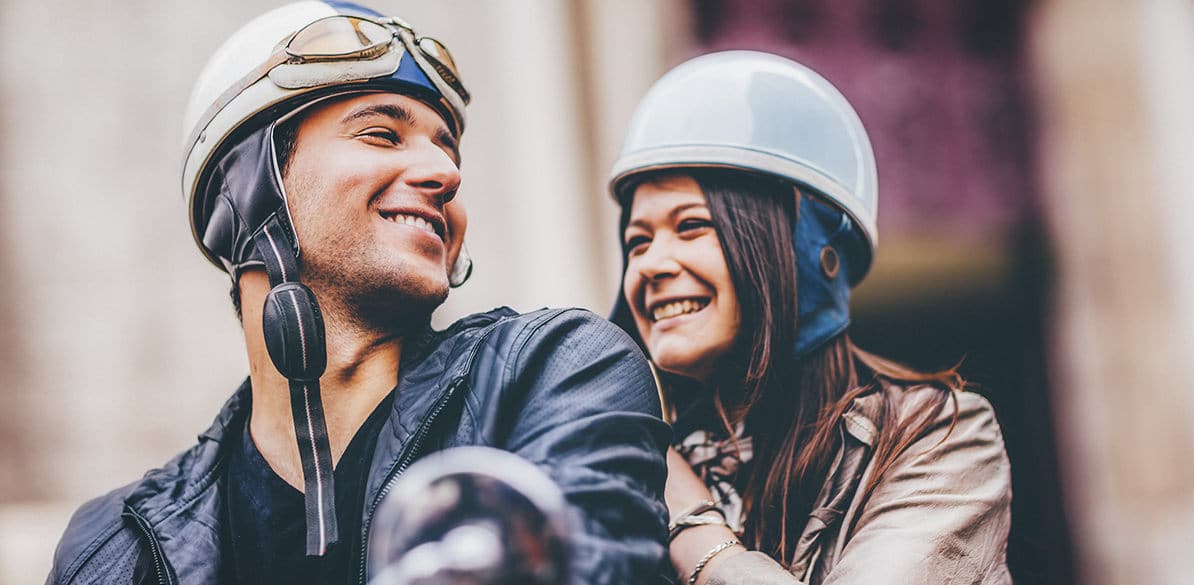Driving your motorcycle safely in the city

Below, we will give you some tips for riding a motorcycle or scooter safely in the city:
The helmet
It may seem pretty obvious, but we must insist on wearing a motorcycle helmet. Even though it is becoming less frequent, every year victims and serious injuries due to not wearing a helmet continue to be recorded. It is precisely on short trips through the city where riders are more confident, but a blow to the head can lead to serious consequences. Remember to wear an approved helmet (preferably a full face helmet) that is the right size for you.
Speed
The characteristics of the motorcycle make it a very dynamic and agile vehicle. However, that should not lead us to believe that we can go faster than everyone else. On city roads, the maximum speed is still 50 kph for motorcycles (45 kph for mopeds) and, even though we want to take advantage of that agility and be more fluid in urban traffic, respect for speed limits is vital. Remember to be especially careful in “30 Zones“ (limited to 30 kph) and in areas marked as residential areas or areas near schools and parks.
Signaling
Lane changes and changes in direction in cities are constant. That is why we must warn other drivers of our intentions as far in advance as possible and in the correct way. The small size of the motorcycle forces us to use headlights, but we should not forget to use blinkers when we make lane changes and changes in direction. It is worth ensuring that other drivers understand our intentions before performing any maneuver.
Motorcyclist gear
Just because we are in an urban area we should not let our guard down with respect to the clothing we wear while on the motorcycle. Even though we are traveling at lower speeds, injuries can be serious if there is an accident. Therefore, it is more than recommended that you wear appropriate gear when riding a motorcycle or a scooter in the city. In addition to a helmet, do not forget to wear suitable gloves, jacket, pants and footwear, regardless of the weather. There is specific clothing for each season of the year and different conditions.
Safe distances
In the city, drivers accelerate, brake and stop constantly. And this can all happen suddenly, which, if we add it to the shorter distances that are generally kept, will almost certainly result in a mishap. Maintain a safe distance from the vehicle in front of you and look past it to determine if traffic conditions change with greater anticipation. Also, respect lateral distances, since when other drivers change direction it is often difficult for them to see you. Be prepared for these maneuvers.
Side view mirrors
The side view mirrors help us keep an eye on angles that are outside our field of vision. Adjust them when stopped and before you start driving. The left and right side view mirrors must give you a view of what is happening behind you and a partial view of the sides. The panoramic view you get from the two mirrors is incomplete, since there are still a few blind spots that we cannot see and where there may be another vehicle. Make sure you move to gain a better angle of view or even turn your head briefly to check that there are no vehicles next to you before performing any maneuver.
Obstacles and traps
There are more traps on the asphalt of a city than you imagine. Paint usually becomes slippery when it rains, so it is best to try and stay on the pavement. The same is true for manhole covers or leaves that have fallen from the trees. It is always best to avoid them. If that is not possible, the right thing to do is to go over them with the motorcycle at a constant speed, without accelerating or braking and keeping the motorcycle as upright as possible. Though it is more difficult to prevent this, as far as possible, avoid passing through areas where the asphalt changes colors (there could be oil spilled from other vehicles). There are also other obstacles from urban amenities, such as posts or lane separation barriers, such as the sloped profile separators along bus lanes, that can get in our way if we do not pay enough attention.
